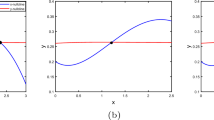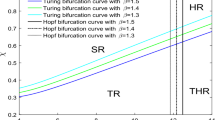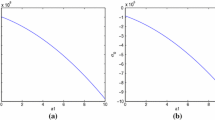Abstract
In this paper, we investigate a diffusive predator–prey model with discontinuous harvesting. The model’s boundedness is explored, as well as the presence and stability of equilibria, Hopf bifurcation, and Turing bifurcation. Additionally, we establish the sliding mode’s existence and study different types of sliding mode bifurcation, including boundary node, grazing, buckling, and crossing bifurcation. Additionally, computer simulations demonstrate that the system may develop a variety of spatial patterns depending on the harvesting threshold, the cost of fear, and the initial conditions.
















Similar content being viewed by others
References
Stephens, P.A., Sutherland, W.J.: Consequences of the Allee effect for behaviour, ecology and conservation. Trends Ecol. Evol. 14(10), 401–405 (1999)
Wang, J., Shi, J., Wei, J.: Predator-prey system with strong Allee effect in prey. J. Math. Biol 62(3), 291–331 (2011)
Barton, N.H., Turelli, M.: Spatial waves of advance with bistable dynamics: cytoplasmic and genetic analogues of Allee effects. Am. Nat. 178(3), 48–75 (2011)
Wang, W., Zhu, Y.N., Cai, Y., Wang, W.: Dynamical complexity induced by Allee effect in a predator-prey model. Nonlinear Anal. Real World Appl. 16(1), 103–119 (2014)
Chen, S., Liu, Z., Shi, J.: Nonexistence of nonconstant positive steady states of a diffusive predator-prey model with fear effect. J. Nonlinear Model. Anal. 1(1), 47–56 (2019)
Cresswell, W.: Predation in bird populations. J. Ornithol. 152(1), 251–263 (2011)
Zanette, L.Y., White, A.F., Allen, M.C., Clinchy, M.: Perceived predation risk reduces the number of offspring songbirds produce per year. Science 334(6061), 1398–1401 (2011)
Wang, X., Zanette, L., Zou, X.: Modelling the fear effect in predator-prey interactions. J. Math. Biol. 73(5), 1179–1204 (2016)
Sasmal, S.K., Takeuchi, Y.: Dynamics of a predator-prey system with fear and group defense. J. Math. Anal. Appl. 481(1), 123471 (2020)
Zhang, H., Cai, Y., Shengmao, F., Wang, W.: Impact of the fear effect in a prey-predator model incorporating a prey refuge. Appl. Math. Comput. 356, 328–337 (2019)
Sasmal, S.K.: Population dynamics with multiple Allee effects induced by fear factors-a mathematical study on prey-predator interactions. Appl. Math. Model. 64, 1–14 (2018)
Wang, J., Cai, Y., Fu, S., Wang, W.: The effect of the fear factor on the dynamics of a predator-prey model incorporating the prey refuge. Chaos Interdiscip. J. Nonlinear Sci. 29(8), 083109 (2019)
Duan, D., Niu, B., Wei, J.: Hopf-hopf bifurcation and chaotic attractors in a delayed diffusive predator-prey model with fear effect. Chaos Solitons Fractals 123, 206–216 (2019)
Wang, X., Zou, X.: Pattern formation of a predator-prey model with the cost of anti-predator behaviors. Math. Biosci. Eng. 15(3), 775–805 (2018)
Luo, J., Zhao, Y.: Stability and bifurcation analysis in a predator-prey system with constant harvesting and prey group defense. Int. J. Bifurc. Chaos 27(11), 1750179 (2017)
Huang, J., Liu, S., Ruan, S., Zhang, X.: Bogdanov-Takens bifurcation of codimension 3 in a predator-prey model with constant-yield predator harvesting. Commun. Pure Appl. Anal 15(3), 1041–1055 (2016)
Guin, L.N., Acharya, S.: Dynamic behaviour of a reaction-diffusion predator-prey model with both refuge and harvesting. Nonlinear Dyn. 88(2), 1501–1533 (2017)
Tiwari, V., Tripathi, J.P., Abbas, S., Wang, J.-S., Sun, G.-Q., Jin, Z.: Qualitative analysis of a diffusive Crowley-Martin predator-prey model: the role of nonlinear predator harvesting. Nonlinear Dyn. 98(2), 1169–1189 (2019)
Gupta, R.P., Chandra, P.: Dynamical properties of a prey-predator-scavenger model with quadratic harvesting. Commun. Nonlinear Sci. Numer. Simul. 49, 202–214 (2017)
Spencer, P.D., Collie, J.S.: Management strategies for fish populations subject to long term environmental variability and depensatory predation. In: Proceedings of the International Symposium on Management Strategies for Exploited Fish Populations, vol. 57, pp. 629–650 (1993)
Bhattacharyya, J., Roelke, D.L., Pal, S., Banerjee, S.: Sliding mode dynamics on a prey-predator system with intermittent harvesting policy. Nonlinear Dyn. 98(2), 1299–1314 (2019)
Mendoza, M.M.E., Amit, B., Eugenius, K., da Iskin, S.C.M.: Threshold policies control for predator-prey systems using a control Liapunov function approach. Theor. Popul. Biol. 67(4), 273–284 (2005)
Rebaza, J.: Dynamics of prey threshold harvesting and refuge. J. Comput. Appl. Math. 236(7), 1743–1752 (2012)
Zhang, X., Tang, S.: Filippov ratio-dependent prey-predator model with threshold policy control. Abstr. Appl. Anal. 280945, 1–11 (2013)
Meza, M.E.M., Bhaya, A., Kaszkurewicz, E.: Stabilizing control of ratio-dependent predator-prey models. Nonlinear Anal. Real World Appl. 7(4), 619–633 (2006)
Tang, S., Liang, J., Xiao, Y., Cheke, R.A.: Sliding bifurcations of Filippov two stage pest control models with economic thresholds. SIAM J. Appl. Math. 72(4), 1061–1080 (2012)
Zhang, X., Tang, S.: Existence of multiple sliding segments and bifurcation analysis of Filippov prey-predator model. Appl. Math. Comput. 239, 265–284 (2014)
Gupta, R.P., Chandra, P.: Dynamical properties of a prey-predator-scavenger model with quadratic harvesting. Commun. Nonlinear Sci. Numer. Simul. 49, 202–214 (2017)
Zhang, X., Zhao, H.: Dynamics analysis of a delayed reaction-diffusion predator-prey system with non-continuous threshold harvesting. Math. Biosci. 289, 130–141 (2017)
Tang, B., Xiao, Y.: Bifurcation analysis of a predator-prey model with anti-predator behaviour. Chaos Solitons Fractals 70, 58–68 (2015)
Cantrell, R.S., Cosners, C., Hutson, V.: Permanence in ecological systems with spatial heterogeneity. Proc. R. Soc. Edinb. Sect. A Math. 123(3), 533–559 (1993)
Filippov, A.F., Aleksei Fedorovich Filippov: Differential equations with discontinuous right-hand side. Matematicheskii Sbornik 93(1), 99–128 (1960)
Tang, S., Liang, J., Xiao, Y., Cheke, R.A.: Sliding bifurcations of Filippov two stage pest control models with economic thresholds. SIAM J. Appl. Math. 72(4), 1061–1080 (2012)
Wang, A., Xiao, Y.: Sliding bifurcation and global dynamics of a Filippov epidemic model with vaccination. Int. J. Bifurc. Chaos 23(08), 1350144:1–1350144:32 (2013)
Yi, F., Wei, J., Shi, J.: Bifurcation and spatiotemporal patterns in a homogeneous diffusive predator-prey system. J. Differ. Equ. 246(5), 1944–1977 (2009)
Hassard, B.D., Hassard, B.D., Kazarinoff, N.D., Wan, Y.-H., Wan, Y.W.: Theory and Applications of Hopf Bifurcation, vol. 41. Cambridge University Press, Cambridge (1981)
Utkin, V.I.: Sliding Modes in Control and Optimization. Springer, Berlin (1992)
Kuznetsov, Y.A., Rinaldi, S., Gragnani, A.: One-parameter bifurcations in planar Filippov systems. Int. J. Bifurc. Chaos 13(08), 2157–2188 (2003)
Acknowledgements
The work is supported by National Science Foundation of China under Grant 11971013.
Author information
Authors and Affiliations
Corresponding author
Additional information
Publisher's Note
Springer Nature remains neutral with regard to jurisdictional claims in published maps and institutional affiliations.
Rights and permissions
About this article
Cite this article
Zhang, X., Zhao, H. & Yuan, Y. Impact of discontinuous harvesting on a diffusive predator–prey model with fear and Allee effect. Z. Angew. Math. Phys. 73, 168 (2022). https://doi.org/10.1007/s00033-022-01807-8
Received:
Revised:
Accepted:
Published:
DOI: https://doi.org/10.1007/s00033-022-01807-8




